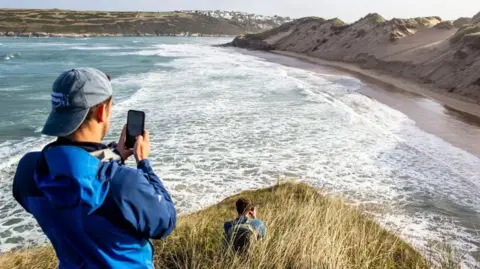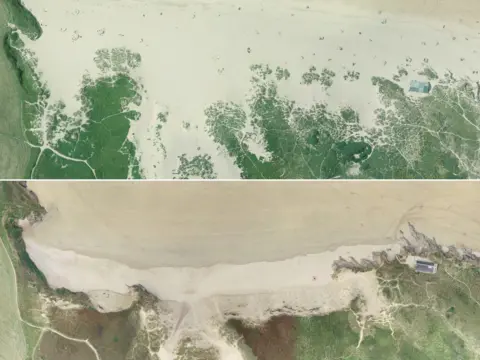Researchers study 'complex' sand dune changes
 Lloyd Russell/ University of Plymouth
Lloyd Russell/ University of PlymouthExperts in coastal processes have found sand dune systems in Cornwall need to be studied individually to project changes over time due to their "complex nature".
Researchers at the University of Plymouth have been monitoring 31 sites along Cornwall's north and south coasts as part of the project.
A principle called the Bruun Rule is commonly used to make projections about how sand dunes will change, but the team found its predictions had not matched what they had witnessed at sites including Crantock and Par Sands.
Prof Gerd Masselink, who led the project, said: "Some shorelines are advancing despite rising sea levels, and others are retreating much faster than predicted."
 Channel Coastal Observatory and Lloyd Russell, University of Plymouth
Channel Coastal Observatory and Lloyd Russell, University of PlymouthHe said the research showed each dune system had to be considered individually "rather than providing a generic prediction based on what might occur along a whole coastline".
The data available went back to 2007, and the team was able to track changes to the dunes until 2020, including seeing how they had been affected by "the most energetic storms ever to hit the Cornish coast".
Some areas had seen dunes retreat and others had advanced.
Researchers found dunes at Par Sands near St Austell had grown by about 3ft (1m) a year, as sand from the beach is blown into them.
At Crantock near Newquay, they found dunes had retreated by about 10ft (3m).
They attribute this to changes in the river channel as it flows into the sea caused by storms, especially in the winter of 2014.
'Significant threat'
Writing in the journal Ocean and Coastal Management, they predict Lelant Towans, Crantock and Rock Dune could retreat more than 328ft (100m) by the year 2100.
The dunes at Par Sands and Hawkers Cove near Padstow are predicted to advance seaward by more than 328ft (100m) in that time, the team said.
Lead author, Liane Brodie said: "It all demonstrates the complex nature of Cornwall's sand dunes and the need to assess each in its own right."
The report said: "climate change poses a significant threat to coastal dunes, and elevated erosion rates are expected due to sea level rise induced changes, a potential increase in storm intensity and a diminishing supply of sediment in many places".
Follow BBC Cornwall on X, Facebook and Instagram. Follow BBC Devon on X, Facebook and Instagram. Send your story ideas to [email protected].
